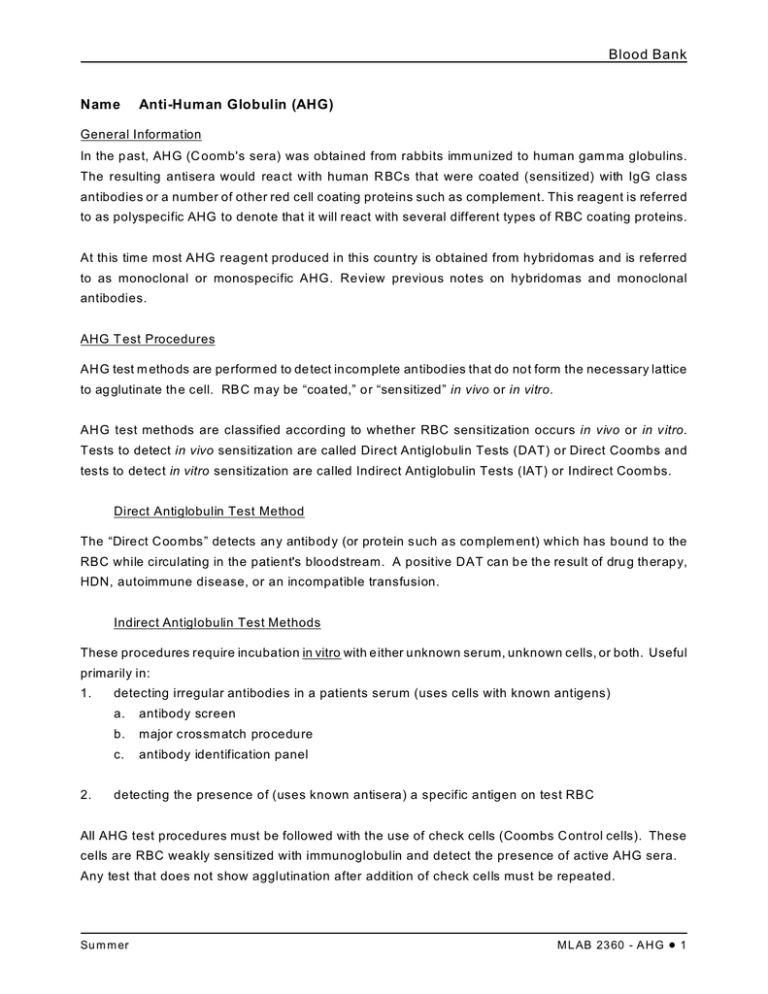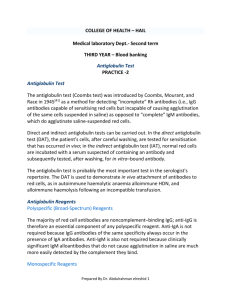Blood Bank Name Anti-Human Globulin (AHG)
advertisement

Blood Bank Name Anti-Human Globulin (AHG) General Information In the p ast, AHG (C oomb's sera) was obtained from rabbits imm unized to human gam ma globulins. The resulting antisera would rea ct w ith human R BCs that were coated (sensitized) with IgG class antibodies or a number of other red cell coating proteins such as complement. This reagent is referred to as polyspecific AHG to denote that it will react with several different types of RBC coating proteins. At this time most AHG reagent produced in this country is obtained from hybridomas and is referred to as monoclonal or monospecific AHG. Review previous notes on hybridomas and monoclonal antibodies. AHG T est Procedures AHG test m etho ds are perform ed to de tect incomplete antibodies that do not form the necessary lattice to ag glutinate th e cell. RB C m ay be “coa ted,” or “sen sitized” in vivo or in vitro. AHG test methods are classified according to whether RBC sensitization occurs in vivo or in vitro. Tests to detect in vivo sensitization are called Direct Antiglobulin Tests (DAT) or Direct Coombs and tests to detect in vitro sensitization are called Indirect Antiglobulin Tests (IAT) or Indirect Coom bs. Direct Antiglobulin Test Method The “Direct Coombs” detects any antibody (or protein such as co mplem ent) which has bound to the RBC while circulating in the patient's bloodstream. A positive DAT can be th e re sult of dru g th erapy, HDN, autoimmune disease, or an incompatible transfusion. Indirect Antiglobulin Test Methods These procedures require incubation in vitro with either unknown serum, unknown cells, or both. Useful primarily in: 1. 2. detecting irregular antibodies in a patients serum (uses cells with known antigens) a. antibody screen b. major crossm atch procedure c. antibody identification panel detecting the presence of (uses known antisera) a specific antigen on test RBC All AHG test procedures must be followed with the use of check cells (Coombs C ontrol cells). These cells are RBC weakly sensitized with immunoglobulin and detect the presence of active AHG sera. Any test that does not show agglutination after addition of check cells must be repeated. Su m m er M L AB 23 60 - A H G ! 1 Blood Bank Sources of Error Consult the AABB Technical Manual for complete listings of false negative or positive results. False Ne gative R esults 1. Inadequate washing of cells will result in neutralization of the antiglobulin serum by trace am ounts of residual globulin. A final concentration of only 2 :g of IgG/ml can cause neutralization of the antiglobulin serum. Thus, the red blood cells have to be washed free of u nbound IgG until it is below this figure. 2. Contamination with human serum will neutralize the reagent. If the reagent dropper is contaminated with serum and replaced in the vial, the entire contents of the vial may be neutralized. 3. Elution of a ntibody from the red blood cells may take place if the test pro cedure is interrupted or delayed, particularly during the washing phase. 4. The optimum temperature for reactivity of the antibody must be maintained during incubation to achieve maximal coating of the cells. 5. A cell suspension th at is too heavy will n ot p ermit op timum coatin g w ith the antibo dy; if too weak, reading agglutination may be difficult. A 2% to 5% suspension of red blood cells is preferred. 6. Test cells, test serum, and antiglobulin serum lose reactivity if improperly stored. 7. Some antibodies may be detected only in the presence of a ctive complement. Anticoagulants such as ACD, CPD, or EDTA will chelate calcium, preventing activation of complement. Thus, the use of plasm a rather than serum may lead to a false negative reaction. O ld or improperly stored serum will a lso have impaired com plement activity. 8. A prozone reaction should not be a problem with licensed products. Standardization is done by the manufacturer, and his directions for the test must be followed. 9. Antiglobulin serum may have been omitted. 10. Under-centrifugation or over-centrifugation. 11. Insufficient incubation time. 12. Fa ilure to check negative re action s m icro scopically. Su m m er M L AB 23 60 - A H G ! 2 Blood Bank NOTE: The lack of agglutination of the presensitized red blood cells (check cells or Coomb's control cells), added following completion of a negative antiglobulin test, will demonstrate a falsenegative determination caused by 1, 2, 6, or 9 above. False Po sitive Re sults 1. Ce lls having a positive direct antiglobulin test (DAT positive cells) cannot be used with reagent antiserums that require an antiglobulin phase, because all such cells will be agglutinated by the antiglobulin serum 2. Bacterial contamination of test cells, or septicem ia in a patient, m ay result in a positive antiglobulin test. If the red blood cells are T-activated, they may react as some antiglobulin sera contain anti-T. 3. Extreme reticulocytosis has been reported to give a positive result because of transferrin bound to reticulocytes reacting with antitransferrin in the antiglobulin reagents. Most antiglobulin reagents tod ay have little antitransferrin activity. 4. Saline stored in glass bottles m ay contain colloidal silica leached from the container; this has been reported to cause false positive reactions. 5. Saline stored in metal containers, or used in equipment with metal parts, may contain metallic ions which may bring about nonspecific protein-coating of the red blood cells. 6. Improperly prepared antiglobulin serum m ay contain traces of species-specific antibodies. 7. W hen all the antiglobulin tests are weakly positive, the cause may be improperly cleaned glassware, or other forms of contamination. 8. Over-centrifugation may give false-positive results. 9. Patients' or donors' serums can contain a naturally occurring cold autoantibody (normal incom plete cold antibody) that can sensitize their own or other cells with com plement. Usually this only occurs at 4°C, but may occur up to room temperature. If antiglobulin sera contain potent anticomplement, positive reactions may occur with red blood cells from refrigerated clots. These positive reactions have been fou nd to be largely a result of C4 sensitization and can be avoided if red blood cells from anticoagulated blood are used. For crossmatching, red blood cells from ACD or CPD segments can be used, and for direct antiglobulin tests EDTA is preferable. These anticoagulants will ch elate CA ++ and Mg++ , thus preventing any in vitro complement uptake without interfering with the complement already bound to the red blood cell in vivo. Su m m er M L AB 23 60 - A H G ! 3 Blood Bank 10. Red blood cells may be autoagglutinated before they are washed and this agglutination may persist through washing, leading to a false-positive reaction when antiglobulin serum is added. Su m m er M L AB 23 60 - A H G ! 4

